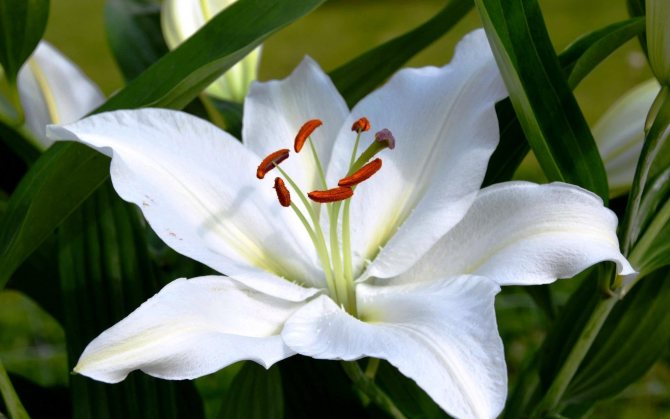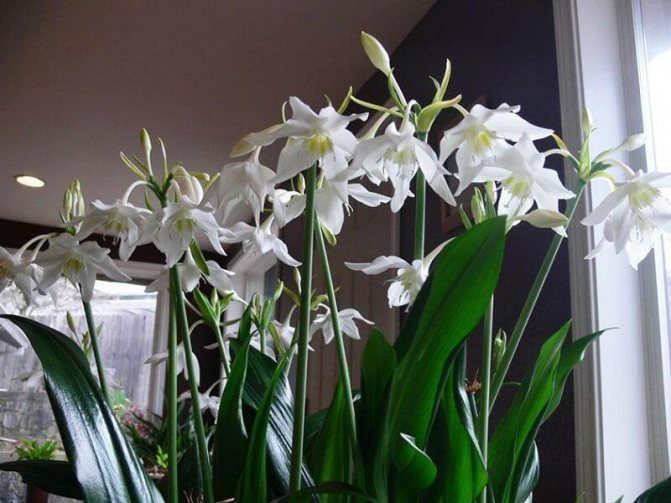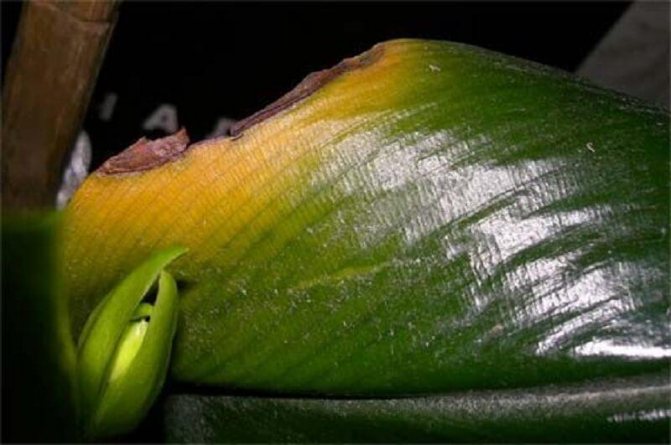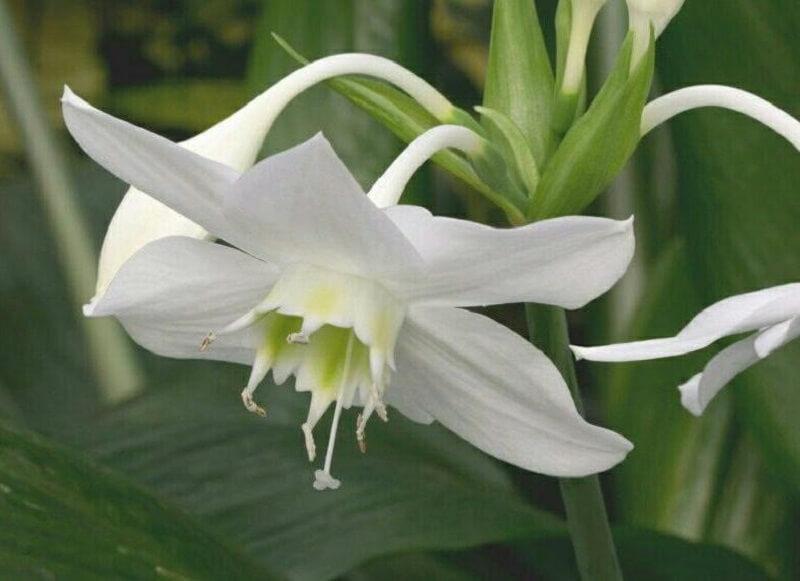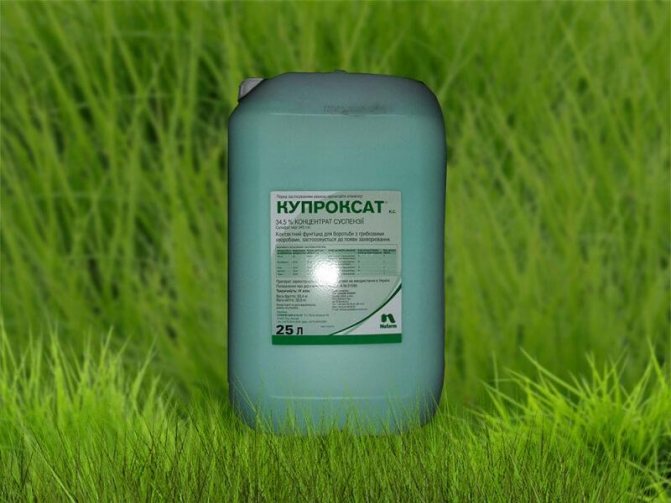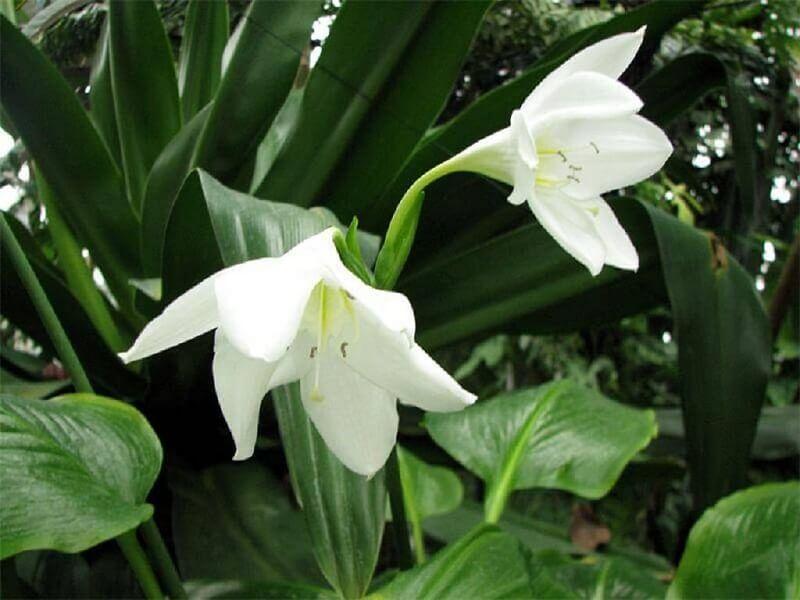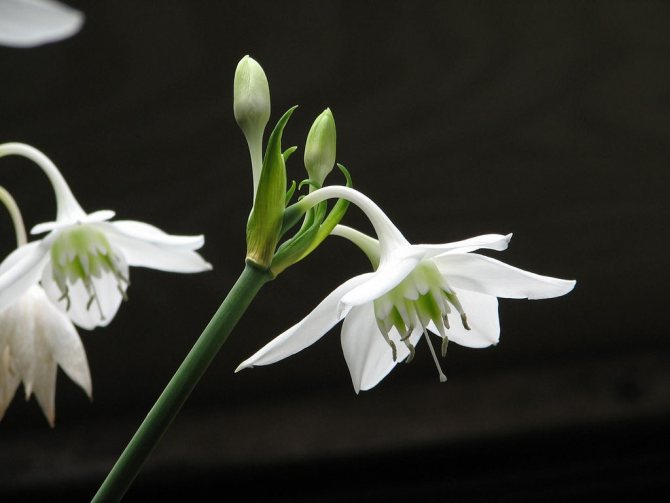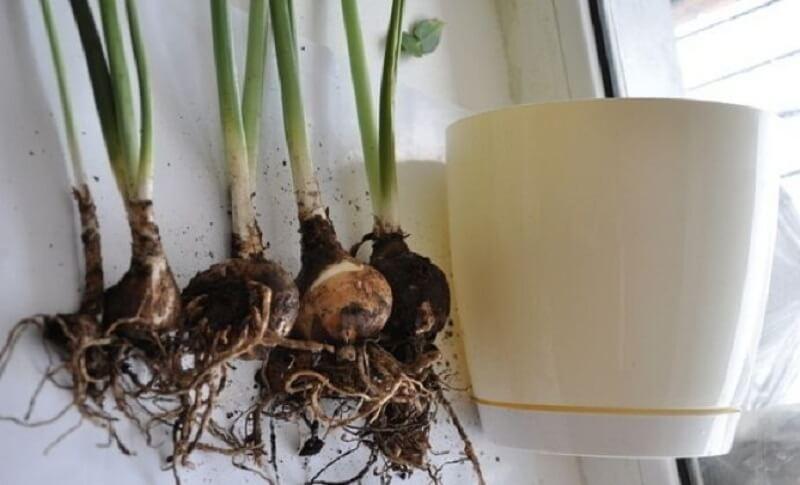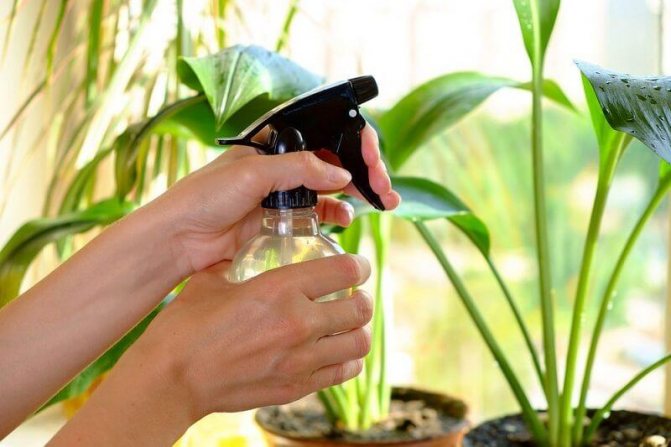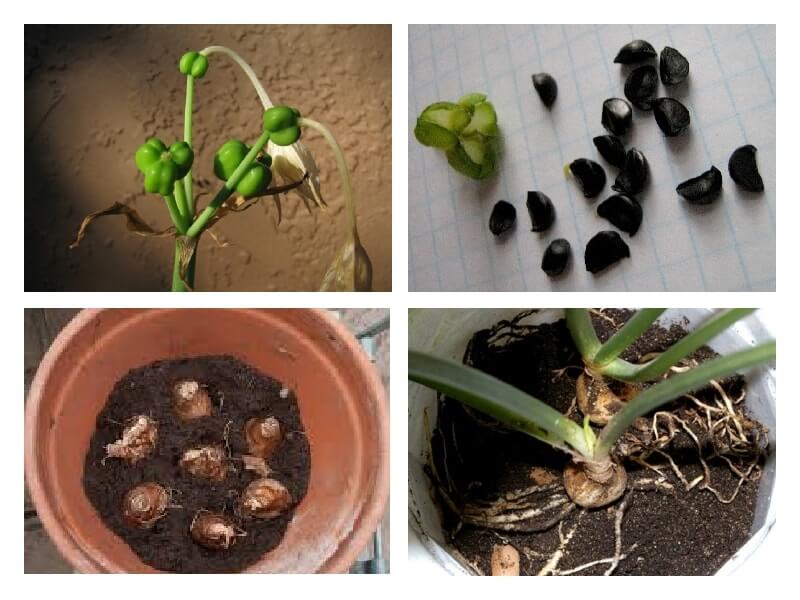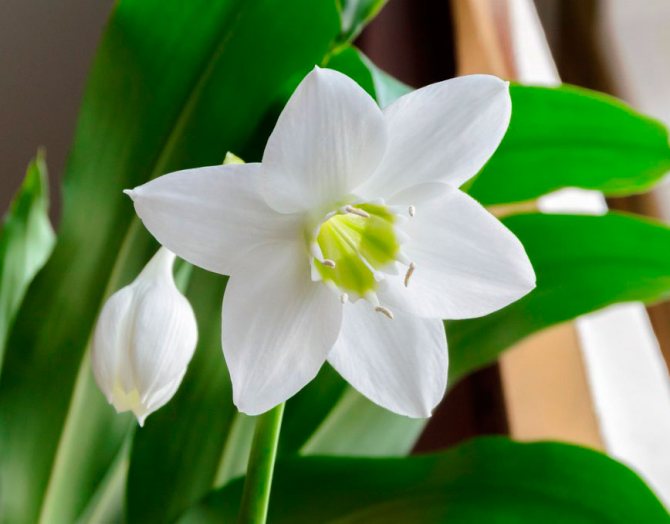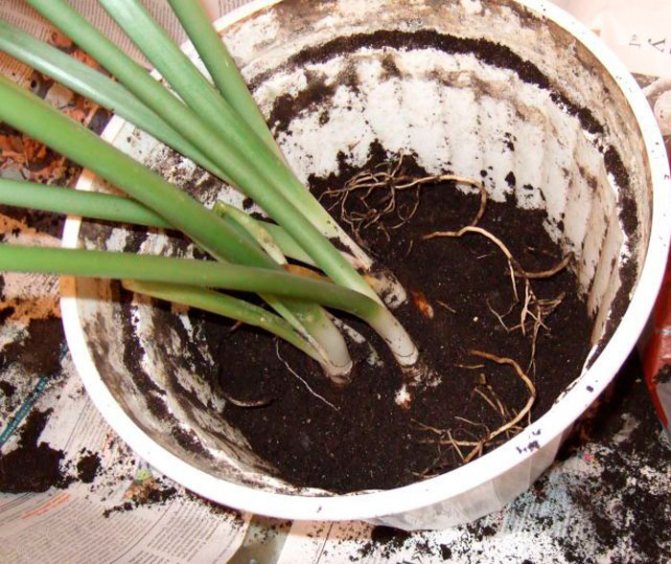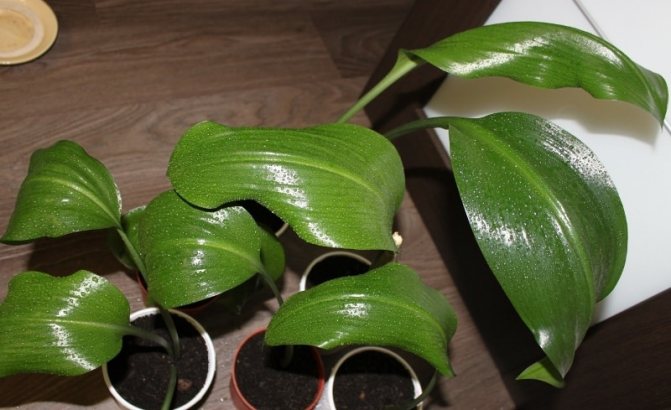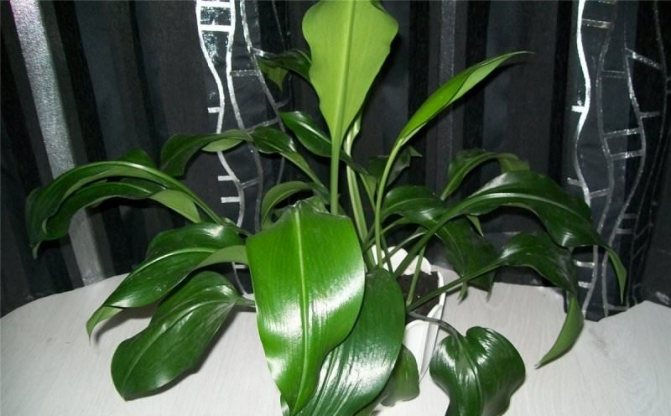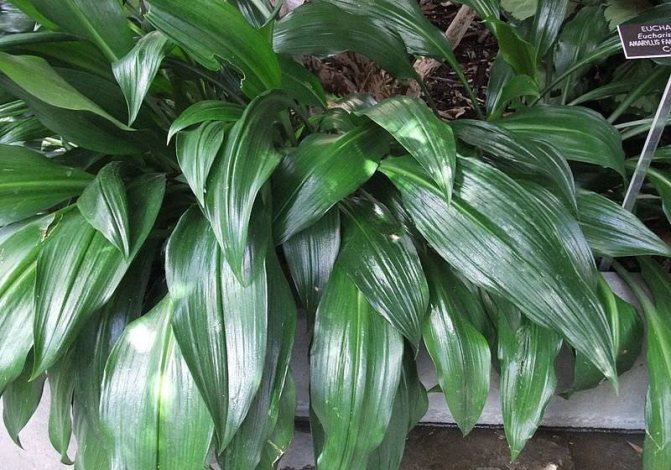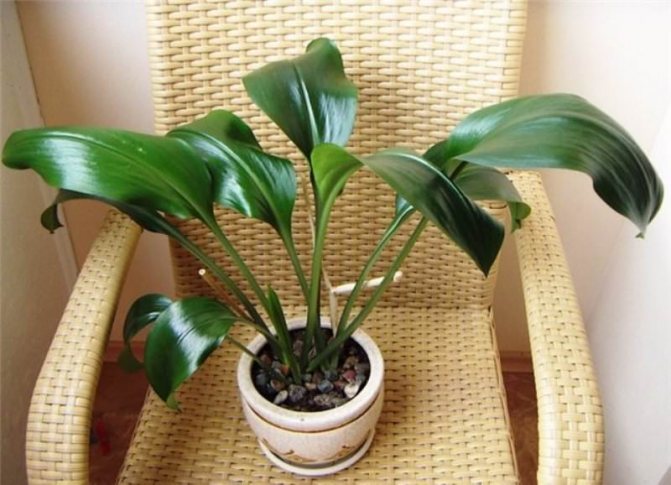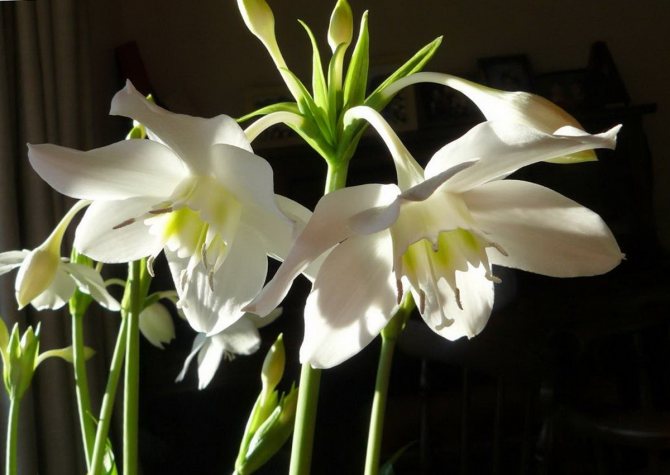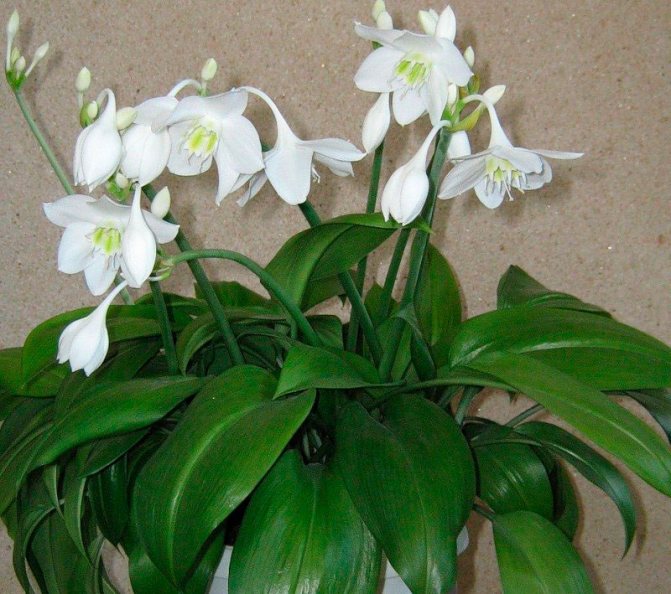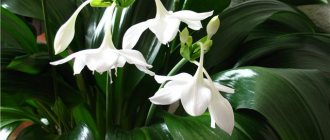Eucharis or Amazonian lily is a very decorative bulbous plant. It has gained a lot of popularity due to its beautiful appearance. Also, this plant is loved for its unusual and very fragrant flowering.
Eucharis blooms in mid-autumn, when most indoor plants have already faded, and some are only growing buds for winter flowering. How to care for eucharis at home? How to transplant eucharis correctly? You will read about this and much more in our article.
Plant buying advice
If you want to buy eucharis, you must first examine the foliage. In a healthy plant, it is dark green and shiny, without curling. It should be free from signs of disease and pests.
It is advisable to buy an already flowering plant, which will be a guarantee that, with the correct content, it will bloom in the future.
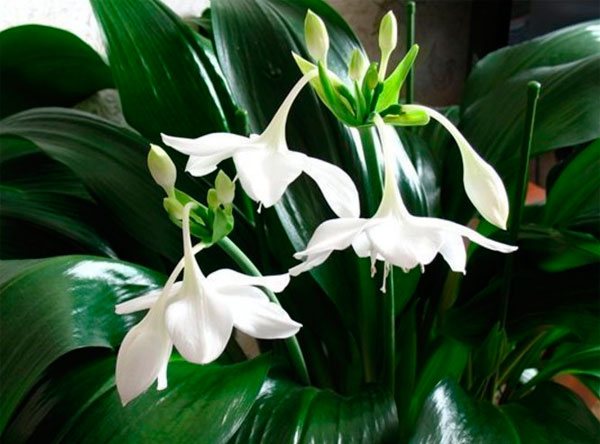
If you need to buy a Eucharis bulb, then it must be well developed and have a healthy appearance. Since if they are weak or rotten, they can quickly become infected with pests, which will require long-term treatment, and possibly its further destruction in case of failure.
The price of eucharis, depending on the type and size, ranges from five hundred rubles to two and a half thousand. The cost of an onion is on average one hundred and fifty rubles. In this case, it is advisable to buy several pieces at once, so that flowering begins faster.
Eucharis is very sensitive to cold, temperatures below fifteen degrees are fatal for him. Therefore, if you are going to buy an Amazonian lily in the winter, you need to pack it securely during transportation.
Homeland of lily
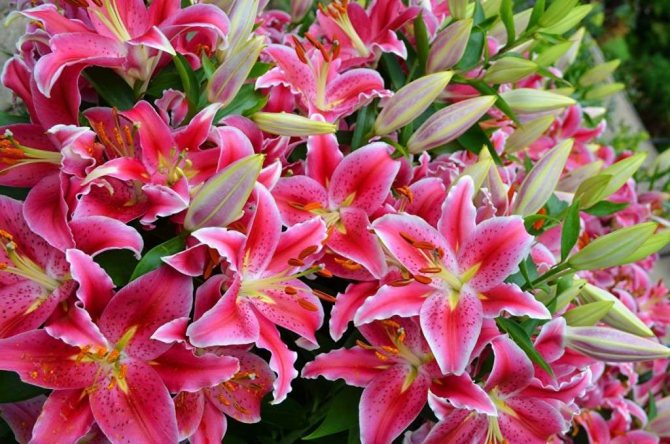

In the wild, lilies grow in the Northern Hemisphere: in Europe, Asia, several species in North America and North Africa. They occupy a vast area between 68 ° N. sh. and 11 ° n. sh. Western China, Southeast Tibet and Northern Burma are especially rich in species of lilies.
Wild lilies are found in mountainous areas and foothills, in forests, in clearings and forest edges, in wetlands or open grassy slopes. In the steppe zone, lilies rarely grow. Cultivated varieties of lilies can grow everywhere in gardens with proper care.
Signs and superstitions that eucharis gave birth to
The Amazon lily in her homeland is considered a powerful female amulet that protects not only her, but the whole family from any setbacks. Her flowers are used to decorate the hair of brides to protect them from envious glances. It is also believed that eucharis contributes to the craving for knowledge, broadening one's horizons and discovering previously unknown abilities, therefore, it is useful to plant it in a house where there are children and students.
In feng shui theory, eucharis is classified as a plant with a powerful positive energy that can cleanse a home or any other room from any negative impact. With the beginning of flowering, he begins to remove accumulated fatigue from people, restore mental balance and charge with vigor.
It removes all heavy thoughts and relieves even the most prolonged depression. In connection with these inherent qualities, it is better to place it in the living room or in the workplace, since in the bedroom, with its activity, it will cause insomnia.
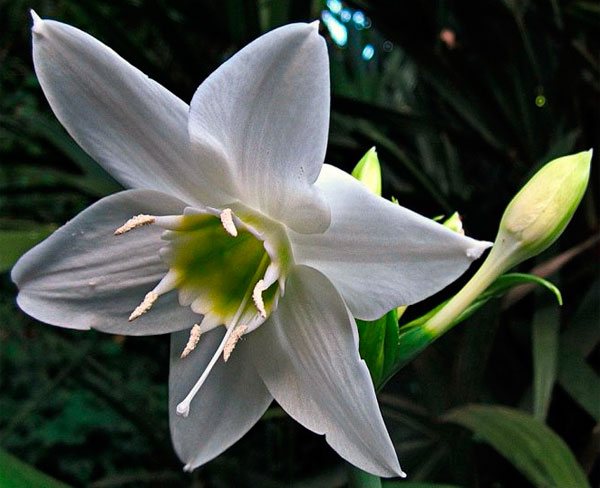

It is scientifically proven to cleanse the air by absorbing harmful compounds and saturating it with oxygen.But, despite all its positive properties, eucharis also has a drawback. It must be kept separate from other plants, as its powerful energy exert powerful pressure on them, which can lead to the death of neighboring flowers.
Reasons why eucharis leaves turn yellow
Despite the fact that eucharis is a rather unpretentious plant, slight difficulties may arise. For example, yellowing or wilting of leaves. It's okay if only a few leaves have turned yellow. With an abundant change in color, you need to urgently take the necessary measures.
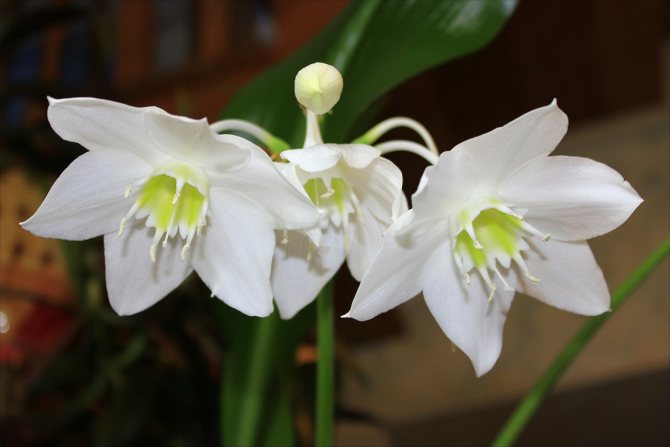

There may be three reasons for this:
- Overdrying;
- Overflow;
- Hypothermia.
Rotten and damaged roots should be carefully removed. Then the plant should be transplanted and the frequency of watering should be reduced. The room shouldn't be very bright. If, upon examination, the roots turned out to be healthy, then this will greatly facilitate the task. You just need to pick off the yellowed leaves. It is impossible to postpone the solution of the identified problem for a long time, because eucharis can quickly and irrevocably die.
Leaves can also turn yellow when watered with hard water.
If leaf discharge occurs in autumn-winter, then this is the beginning of plant dormancy, which occurs due to a lack of heat and light. At the edges, the leaves turn yellow when the soil is too dry. Watering should be normalized. If, during the growth of new leaves, the old ones begin to turn yellow, this means that the conditions of care have been violated. And if young leaves turn yellow, then this is definitely from an excess of moisture. It is necessary to restore the correct watering, because the bulb has already begun to rot a little.
Eucharis species common in indoor floriculture
Only a few varieties of eucharis are grown indoors. The most popular among them include the following types:
- Large-flowered, with almost round, brown-coated bulbs. Each shoot contains up to four wide oval leaves up to thirty centimeters long and up to sixteen wide. They have a dark green color and long petioles. From three to six flowers, collected in an umbrella inflorescence, which is crowned with rounded peduncles. They are large, up to twelve centimeters in diameter, pure white in color. With good care, flowering can occur in early May, late August and during winter;
- White, with an egg-shaped bulb. The wide, pointed foliage has an elliptical shape, up to forty centimeters long and up to fourteen wide. Peduncles with six to ten white flowers with a pleasant smell are brown-green in color. This species blooms in early March and then during the winter months;
- Masterza has an ovoid bulb. Green wide, elongated leaves up to twenty-five centimeters in length and up to fourteen in width have short petioles. Flowers are collected in umbrellas, their rounded petals are up to three centimeters long, and the throat is up to nine centimeters in diameter. Flowering occurs in early spring;
- Sander with an ovoid bulb, it has wide heart-shaped leaves up to thirty centimeters in length and up to seventeen in width, petioles are up to fifteen centimeters long. Rounded peduncles contain up to three white flowers. It blooms in mid-spring and late autumn. There is a multi-flowered variety with five to six flowers on a peduncle;
- Toothless with ovoid bulbs, its triangular-oblong foliage is up to twenty-three centimeters long and up to eleven centimeters wide. Petioles are long, on narrow peduncles, there are up to eight white flowers, collected in umbrellas. It blooms in early spring and late autumn.
Wallis spathiphyllum, like other varieties of this plant, is described in detail here.
And this article is useful for those who want to learn how to care for spathiphyllum at home.
Here you can find out why your spathiphyllum is not blooming.
Briefly about the plant and growing conditions
On the shores of the Amazon and at the foot of the Andes of South and Central America, you can find in nature the exquisite Eucharis flower - this is the birthplace of the plant.
Short description:
- grows from a bulb;
- blooms - 2-3 times throughout the year;
- shaded areas for growth, illuminated and with diffused light are suitable;
- indoor lily with wide leaves in summer prefers air temperature - 22-25 ° C, in winter - not lower than 16-18 ° C;
- it should be watered 2 times a week, and at rest - when the top layer of the soil mixture dries up;
- to create tropical conditions, water is sprayed over the foliage, pebbles are poured into the pan and periodically moistened;
- Amazonian lily requires feeding during the growing season with liquid fertilizer with a low percentage of nitrogen - 2 times a month;
- after flowering, you need to help the plant enter the resting phase for 1-1.5 months;
- the plant should be transplanted every 3-4 years, propagated by seeds or children (bulbs);
- it is necessary to fight and prevent harmful insects: spider mites, thrips, scale insects and aphids, as well as from diseases: gray rot and red burns.
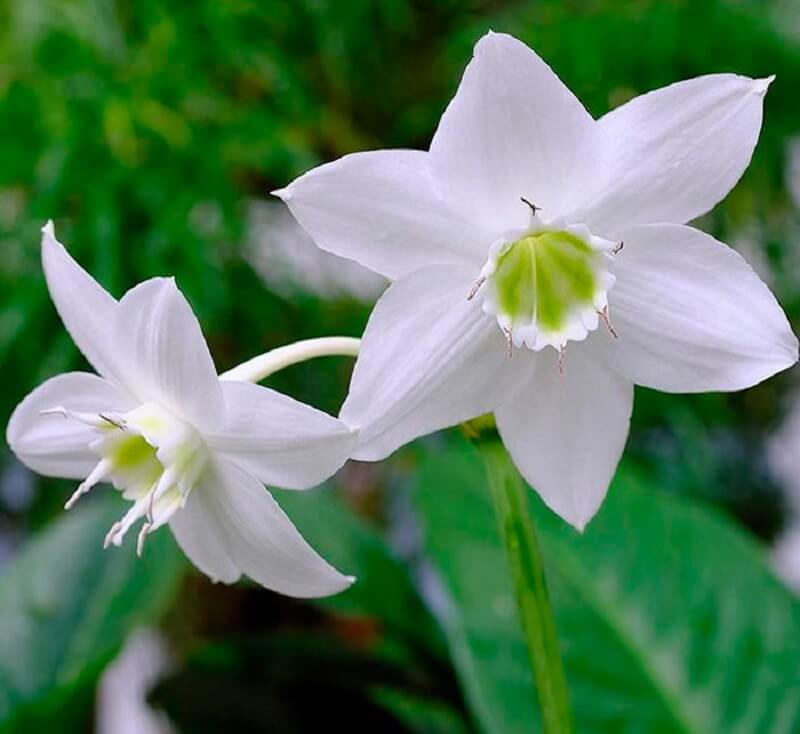



Important! When the temperature drops to 10 ° C and below, the plant sheds its leaves, and the bulb rots. When the plant is in a draft, flowers will not form. With sharp temperature drops, flowers grow small.
The Amazonian lily grows from globular bulbs up to 6 cm in diameter. One bush forms from 2 to 7 wide lanceolate leaf blades of dark green color, and with thick long petioles. The leaves grow in length - up to 55 cm, in width - up to 20 cm. Their structure is wrinkled, there is a protruding longitudinal vein. At the ends of long peduncles - up to 80 cm, large buds bloom in August-September. They are collected in umbrellas - 3-10 pcs., And resemble daffodils in appearance, but they are larger in size. The color of the petals can be white, and the "crown" of the flower is green or yellow. Seeds ripen in a leathery three-chambered fruit capsule.
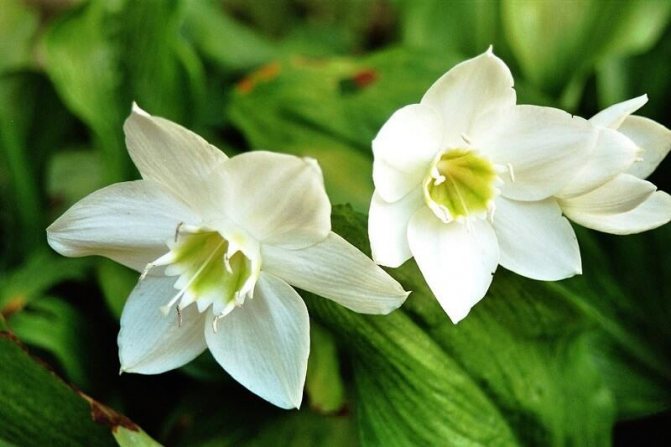

Care and transplantation of the indoor eucharis flower at home
Despite all its extraordinary beauty, it is quite simple to care for eucharis, it is enough to follow some simple recommendations. With proper maintenance, the plant lives in the house for many years and blooms regularly.
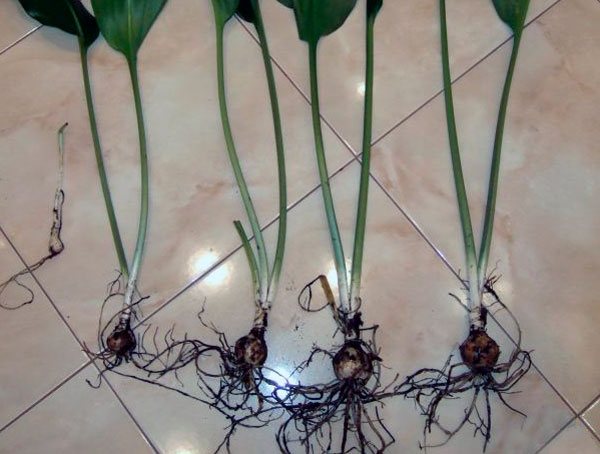

Eucharis is best placed in the eastern or western part of the room. If the plant is in the south in direct sunlight, then good shading should be organized. In the northern part, the Amazonian lily should not be placed, because it may not bloom. If possible, place the plant outdoors in summer.
Since the Amazonian lily is a native of the hot tropics, it also prefers a high temperature in indoor conditions. In the summer, the plant must be kept in the range from twenty-three to thirty degrees. In winter, the temperature is lowered to twenty degrees, but not lower than fifteen.
Temperature drops and drafts should not be allowed, since eucharis can completely shed leaves, the same thing happens when the air temperature is too low.
Humidity does not really matter for the plant. But if the dryness is too high, you need to regularly wipe the foliage with a damp cloth and spray. It is necessary to ensure that the water does not fall on the flowers, it causes the appearance of brown spots on them.
Eucharis needs abundant watering every three days. The water should not stagnate, this can cause rotting of the bulbs. Bottom watering through a sump is preferred.
Plant feeding is carried out constantly, with the exception of the dormant period, using organic or complex mineral fertilizers.With the onset of flowering, you need to use mixtures that contain a large amount of potassium and a minimum of nitrogen. The frequency is once every two weeks.
After flowering is complete, eucharis needs to provide a dormant period., which lasts up to one and a half months. At this time, watering should be minimal, just so as not to overdry the very earthen lump, feeding stops altogether. This will ensure the preservation of existing leaves, but will not allow new ones to form. The plant must be transferred to a shaded place with an air temperature of about eighteen degrees, but not lower.


The soil for planting eucharis should be loose, nutritious, air and moisture permeable. From ready-made soils, special soil for bulbous plants or begonias is suitable. For self-preparation, you can use the following formulations. Take two parts of leafy earth, one part each of sod land, peat and coarse sand (vermiculite, perlite).
Another mixture is also suitable: four parts of leafy soil, two parts of compost, two parts of coarse sand and one part of loam. If possible, a small amount of crushed charcoal should be added to the prepared soils to prevent bulb rotting.
Planting pots should be spacious, as the Amazon lily quickly forms daughter bulbs, which will soon bloom. A small capacity will inhibit their formation, and, therefore, flowering will be less lush. In addition, a powerful adult plant can turn it over. There must be drainage holes at the bottom of the pot. It is also desirable to have a pallet from which to water.
Diseases and pests
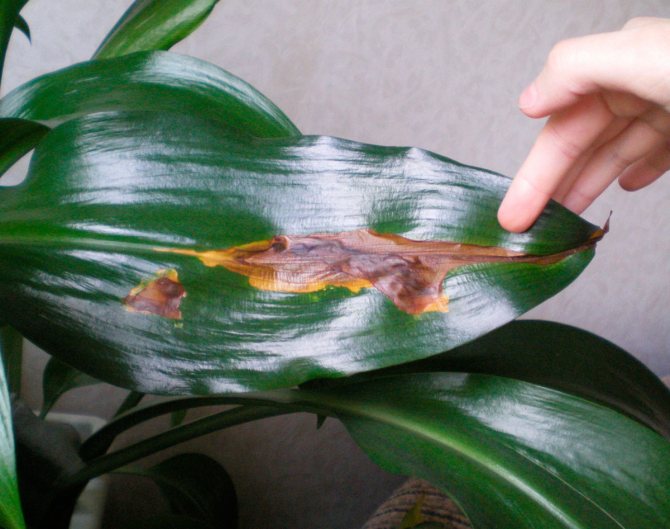

Pests
Eucharis has a fairly high resistance to pests, however, scabbards, thrips or spider mites sometimes settle on it. Most often, those plants that are not properly cared for suffer from them. In order to exterminate such insects, you will have to spray the bush with a systemic insecticidal drug (for example, Fitoverm or Aktellik), they can be found on the shelf of any specialized store. However, it is better to provide the plant with proper care and optimal conditions for growth, then pests will bypass it.
Diseases
Most often, the culture suffers from gray rot. As a rule, the development of such a disease is facilitated by high humidity in a cool room. As soon as you notice the first signs of the disease, it will be necessary to sharply reduce the watering, then the bush is sprayed with a solution of the agent used to combat gray rot, for example: Champion, Bordeaux mixture or Topaz (at the initial stage of the development of the disease). All severely affected areas on the bush are cut out to healthy tissue. In this case, it will be necessary to treat the wounds with a contact agent containing copper, for example: cuproxate, copper sulfate or oxychom.
Possible problems
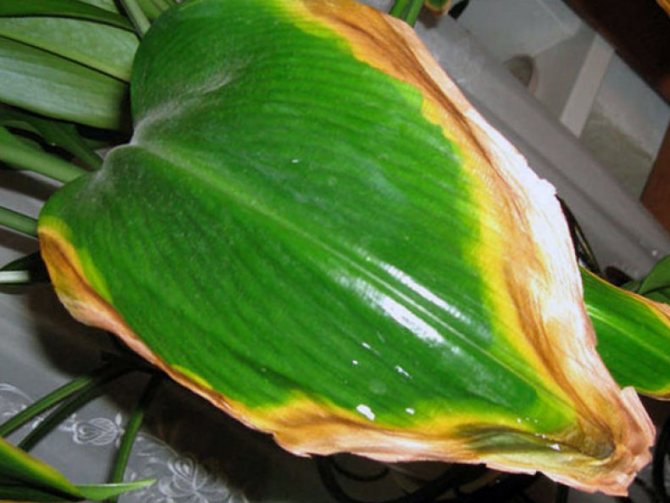

If such a plant is improperly taken care of, then problems may arise with it:
- Eucharis does not bloom... If you take care of the bush correctly, then it will bloom 2, and sometimes 3 times during the year. However, it happens that the eucharis does not want to bloom. To fix this, you first need to understand why this is happening. In order for the transplanted cut to bloom as soon as possible, it should include several bulbs. This is because one bulb, planted in a separate pot, will not bloom until many children have grown, and this usually takes 3-5 years. This is the most common reason for the lack of flowering. Another bush may not form flowers due to sudden changes in temperature or drafts. In this case, it will be enough to start caring for the plant correctly, and it will bloom regularly again.
- How to make it bloom? To do this, for the winter, the bush is placed in a shaded and cool place, watering is greatly reduced (the clod of earth in the pot should dry out almost completely), and you should also stop fertilizing the soil. As a result, with the onset of spring, the bush will begin to grow actively and will certainly delight you with lush flowering.
- Yellow foliage... In the event that only one or two sheet plates have become yellow, then this is a completely natural process. But if the foliage turns yellow massively, and even spots of a dark color appear on its surface, this means that urgent measures need to be taken to save the flower. Yellowing of foliage is observed when: the plant does not have enough water due to excessively poor or rare watering, liquid regularly stagnates in the soil mixture, and also due to hypothermia of the bush.
- Flying around foliage... In the case when the foliage not only turns yellow, but also dies off, it is necessary to remove the bush from the pot and carefully examine its root system. Cut out any areas affected by rot and apply charcoal powder to the wounds. After that, the bush is planted in a fresh substrate. At first, the eucharis should be warm, and it is also provided with moderate watering and reliable protection from direct sunlight. If there are no rotten areas on the root system, then foliage flying around is associated with improper care.
How to transplant eucharis yourself
It is best to transplant the Amazonian lily in the spring, after the first flowering is over. This should be done very rarely, about once every four to six years. This is due to the fact that eucharis is very difficult to tolerate any intervention in the root system, moreover, during this time a sufficient number of daughter bulbs will grow, some of which must be left with the mother plant for splendor of flowering, and some can be used for reproduction.
To transplant eucharis at home, you need to very carefully remove the plant from the pot, trying minimally touching the roots... The outer bulbs are separated for further propagation, the remaining ones are transplanted into a new pot with correctly formed soil and a good drainage layer.
If there are bulbs without leaves, they must be carefully selected and then planted so that the top is on the surface. Those with leaves are buried five to ten centimeters into the soil, depending on size. The substrate must be tamped down and lightly watered.
After about a month and a half, when the bulbs begin to actively grow foliage, it is necessary to start feeding, abundant watering and normal care.
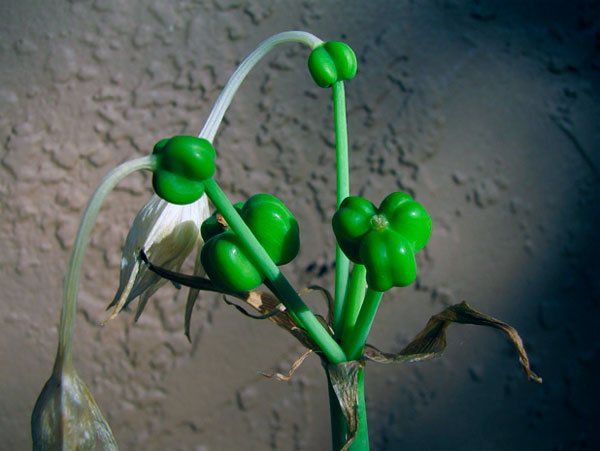

Features of flowering plants
Indoor lily or house lily in a pot - how to care
The Amazonian lily has its own characteristics in flowering. The most important of them is the rest period.
A period of activity and rest
The period of activity for this plant usually occurs in spring or autumn, but there are exceptions. At this time, the plant blooms and pleases with its pleasant appearance and aroma.
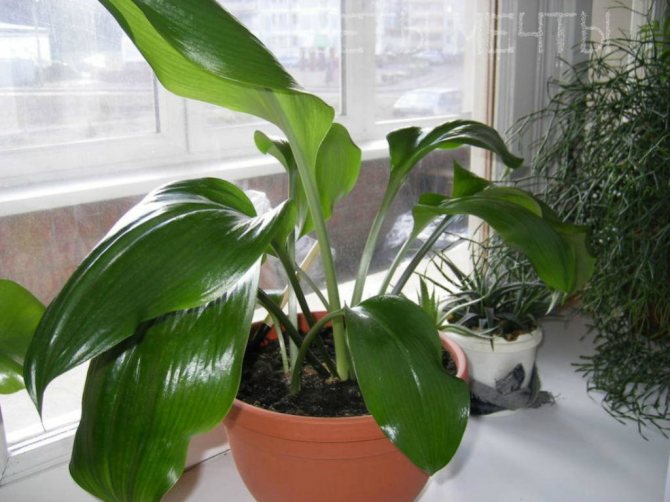

Eucharis at rest
The Amazonian lily can bloom once or twice a year. The flowers open alternately and are in this state for about a week, and the whole inflorescence is for three whole weeks, so watching the eucharis bloom is very exciting.
Additional Information! With careful care, eucharis can even bloom three times a year. Experienced growers achieve this with the right care.
After the end of flowering, a dormant period begins. At this time, you will need to reduce the indoor temperature to 15 degrees, do not feed the plant and water less than usual. Also, during the dormant period, the Amazon lily cannot be transplanted. It is necessary to end this period when new leaves become visible in the soil.
Types and shape of flowers
All the flowers of the Amazonian lily are similar - they have a green core, they are white, resemble a daffodil or lily.Inflorescences can collect up to ten buds.
It is also important to highlight that all eucharis inflorescences are umbellate. The color can be darker or lighter, depending on the type of flower.
How Amazon Lily Reproduction Can Be Produced
Propagation by daughter bulbs
During the eucharis transplant, you need to separate the babies from the main bulb and transplant them into separate pots, several pieces each. So they will quickly braid the soil ball and bloom. The separation should be done very carefully, taking care not to damage the roots.
Containers with plantings need to be slightly moistened and sent to a shaded room for two to three weeks until they take root and grow. After that, they must be transferred to a permanent place of growth and looked after as usual, watered abundantly and fed regularly. Amazon lilies obtained in this way usually bloom after a year.
Propagation of eucharis by seeds
The cultivation of eucharis seeds is used mainly by breeders, at home it is practically not used... This is a rather troublesome process, and plants grown from seeds begin to bloom no earlier than five years later. But, if there is a desire to experiment, then artificial pollination can be carried out, as a result of which, after the end of flowering, a fruit is formed in the form of a three-lobed box with large seeds in a fleshy skin.
Eucharis seeds must be planted in warm soil, moistened, tightened with plastic wrap and sent to a warm and humid room. After several leaves are formed on the seedlings, they can be planted in separate pots, several pieces together.
Transplant rules
- It is not easy for the Amazon lily to endure transplants, therefore, it is transplanted no more than once every 3-4 years during the dormant period, when the roots are strongly entwined with the soil, and the bulbs will be cramped in their usual pot.
- It is also advisable to transplant the plant immediately after purchase. Usually the pot in which the flower is sold and the soil are not suitable for its normal development, but are only suitable for transportation.
- When transplanting an Amazonian lily, unlike other bulbous, children are not specially separated, except when the plant needs to be propagated.
- The container should be roomy, wide, but shallow, 2-3 cm wider than the previous one. At the bottom there is a thick drainage layer. Nutritious soil, from sod and leafy soil, with the addition of sand and rotted manure.
- The plant is transferred to a new container by the transfer method, carefully removing the plant along with a clod of earth. Empty places in the pot are covered with fresh soil and tamped well.
- After transplanting, for the first month, the eucharis is watered in a gentle way, so that before the next watering, the soil dries out by two-thirds of the pot. But you need to spray often, using a sufficient amount of warm water.
A sign that the plant has tolerated the transplant well will be the appearance of new leaves.
The rest of the nuances of the transfer can be found here.
Dangerous diseases of eucharis
The most common pests of eucharis are scale insects, thrips and spider mites. But they appear only in case of improper care of the plant or when its immunity is weakened. If the leaves began to turn yellow, then this is a sure factor in the fact that the plant is sick.


There are several ways to get rid of pests:
- Rubbing leaves with soapy water.
- Areas damaged by gray mold are cut out and treated with, for example, copper sulfate.
- Insecticides are used when insects appear on foliage.
If red spots appear on the leaves, then this is a sure factor that the plant has received a red burn. This is a fungal disease that attacks almost all bulbous plants. Fungicides, which contain copper, help to thoroughly fight this disease. If the bulb begins to rot, then it is likely that it is affected by daffodil flour.Actellik will help in such a situation. If you dilute the drug with 5 liters of water and soak the bulbs in it, they will remain alive.
Eucharis is a stunning plant that is sure to brighten a room with its presence and amazing scent. And its greenery will be a great addition to other indoor plants.


